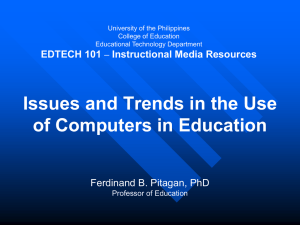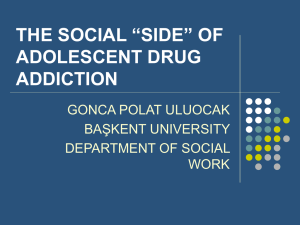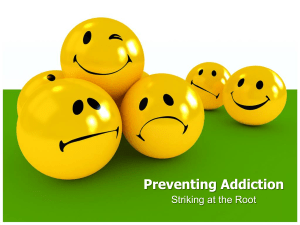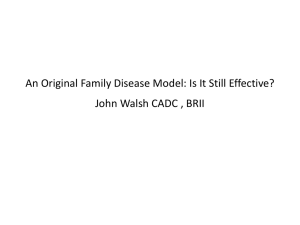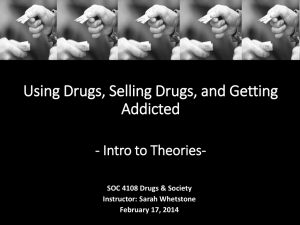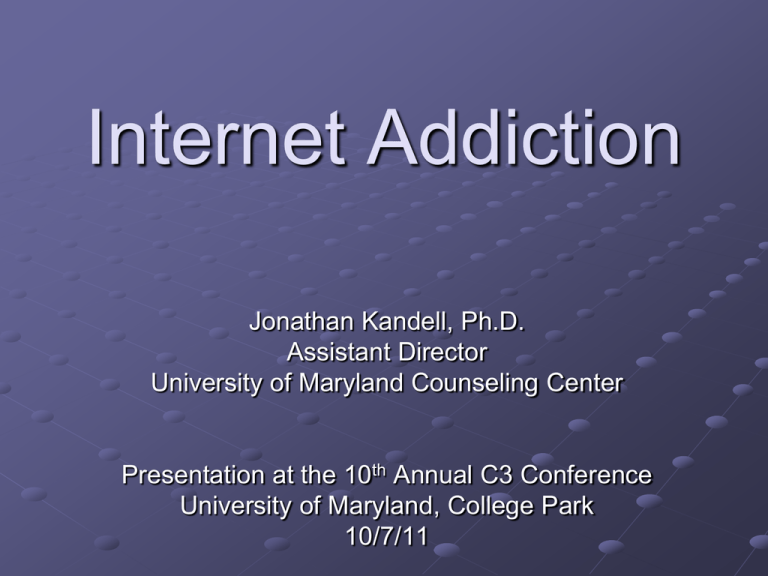
Internet Addiction
Jonathan Kandell, Ph.D.
Assistant Director
University of Maryland Counseling Center
Presentation at the 10th Annual C3 Conference
University of Maryland, College Park
10/7/11
Overview
What is Internet Addiction?
Vulnerability of College Students
Nature of Technology
Cutting Edge … or Cutting Off?
Patterns and Suggestions
Treatment of Internet Addiction
What is
Internet Addiction?
What is Internet Addiction?
How would you define it?
What is Internet Addiction?
How would you define it?
Term coined in the mid-90s by a New
York psychiatrist, Dr. Ivan Goldberg
He devised a list of symptoms (taken from
those for pathological gambling) and
created “Internet Addiction Disorder”
Also created online Internet Addiction
Support Group
What is Internet Addiction?
How would you define it?
Term coined in the mid-90s by a New
York psychiatrist, Dr. Ivan Goldberg
He devised a list of symptoms (taken from
those for pathological gambling) and
created “Internet Addiction Disorder”
Also created online Internet Addiction
Support Group
Did it as a joke!
What is Internet Addiction?
How would you define it?
Term coined in the mid-90s by a New
York psychiatrist, Dr. Ivan Goldberg
He devised a list of symptoms (taken from
those for pathological gambling) and
created “Internet Addiction Disorder”
Also created online Internet Addiction
Support Group
Did it as a joke!
The joke was on him!!
What is Internet Addiction?
“Process Addiction” – disorder of
behavior, not abuse of a substance
What is Internet Addiction?
“Process Addiction” – disorder of
behavior, not abuse of a substance
“Pathological Internet Use” (PIU)
Term coined by Kimberly Young, Ph.D.
- Psychologist, U. Pitt-Bradford – COLA
Many liken IAD/PIU to pathological
gambling (e.g., Goldberg and Young),
using symptoms from those disorders
What is Internet Addiction?
“Pathological Internet Use” (PIU)
Given the usefulness/necessity
of the Internet –
more like compulsive exercise
What is Internet Addiction?
Symptoms
Increasing preoccupation with, and investment of
resources (e.g., time, money, energy) on
Internet-related activities
Unpleasant feelings (e.g., depression, anxiety,
loneliness, emptiness) when not online
Negative impact on work/school performance
Problems develop in existing relationships
Difficulty in forming new offline relationships
Tolerance can develop
Denial
What is Internet Addiction?
Research Findings – Literature
5-12% of Those Surveyed
have PIU
What is Internet Addiction?
Research Findings – Literature
Personality Characteristics
Low self-esteem
Intellectualization
Self-reliance
Strong preference for solitary activities
Restricted social outlets
Less socially conforming
More emotionally reactive to others
(VanGelder, 2003)
What is Internet Addiction?
UM Counseling Service Data (2006-07)
Full
Entire Helpseeker Population (N=1125)
PIU
Clients responding “Terribly” or “Poorly” to “How
have you been getting along in the following areas
of your life over the last two weeks?” – Spending
too much time on the computer/Internet (N=170)
What is Internet Addiction?
UM Counseling Service Data (2006-07)
Out of 66 items on the four scales
60 showed an increase in endorsement
6 showed a decrease
What is Internet Addiction?
UM Counseling Service Data (2006-07)
Out of 66 items on the four scales
60 showed an increase in endorsement
6 showed a decrease
42.45% average rise in endorsement
(includes items that decreased)
What is Internet Addiction?
UM Counseling Service Data (2006-07)
Item
Repeated behaviors interfere w/ life
Standing up for rights, express self
School (performance, attendance)
Studying effectively
No energy, everything an effort
Self management (plans, goals)
Afraid of / avoiding normal situations
Feeling hopeless about the future
Eating problems
Uncomfortable, shy, ill at ease
FULL
26.04%
15.11
23.72
38.49
24.53
39.12
23.29
25.42
24.44
19.11
PIU
52.35%
30.00
45.88
72.94
46.47
71.18
41.18
42.35
40.00
31.18
What is Internet Addiction?
UM Counseling Service Data (2006-07)
Item
Making friends
Self-confidence, self-esteem
Career conflicts within self
Difficulty concentrating
Loneliness
Feeling sad most of the time
Grief over death of loved one
Not liking yourself
Feeling nervous
Intimate relationships
FULL
19.91%
40.00
35.22
51.02
42.04
33.16
8.62
28.18
37.07
29.83
PIU
30.59%
61.18
52.94
75.88
60.59
45.29
11.76
38.24
49.41
39.41
What is Internet Addiction?
UM Counseling Service Data (2006-07)
Item
Rape or sexual assault
Alc/drugs causing physical problems
Pregnancy
Getting into frequent arguments
Alc/drugs interfering w/ job/school
Sexual orientation issues
FULL
3.11%
2.04
0.71
11.20
2.31
4.00
PIU
2.94%
1.76
0.59
8.82
1.76
2.94
What is Internet Addiction?
In my opinion, Pathological Internet Use
is most often a condition secondary to a
separate underlying psychological
disorder. The compulsive internet
behavior is functioning as a coping
mechanism, a form of self-medication similar
to other compulsive/addictive behaviors.
Vulnerability of
College Students
Vulnerability of College Students
Societal Influences
Increasing pace of life and technological
advancement – Toffler’s “Future Shock”
Threats to safety (real and/or perceived)
Environmental, political, financial worries
Vulnerability of College Students
Societal Influences
Increasing pace of life and technological
advancement – Toffler’s “Future Shock”
Threats to safety (real and/or perceived)
Environmental, political, financial worries
Familial Influences
Usual dysfunction, financial issues, etc.
“A Nation of Wimps” – Marano
The Fragility Factor (“Helicopter Parents”)
Cell Phone – “The Eternal Umbilicus”
Vulnerability of College Students
Developmental Influences
Erikson (1963) – 8 Stages of Life
Basic Trust vs. Mistrust
Autonomy vs. Shame, Doubt
Initiative vs. Guilt
Industry vs. Inferiority
Identity vs. Identity Diffusion (Role Confusion)
Intimacy vs. Isolation
Generativity vs. Stagnation
Ego Integrity vs. Despair
Vulnerability of College Students
Developmental Influences
Erikson (1963) – 8 Stages of Life
Basic Trust vs. Mistrust
Autonomy vs. Shame, Doubt
Initiative vs. Guilt
Industry vs. Inferiority
Identity vs. Identity Diffusion (Role Confusion)
Intimacy vs. Isolation
Generativity vs. Stagnation
Ego Integrity vs. Despair
Vulnerability of College Students
Access / Expectancy
Most campuses replete with computers and
internet connections
Computer labs often open late, even 24/7
Many courses require (or strongly
encourage) use of computer / internet
Writing Papers
Internet Research
E-mail Instructors
Online Discussions
Blackboard / ELMS
Vulnerability of College Students
Access / Expectancy
It only takes a few keystrokes to go from
writing a paper to checking your e-mail to:
Facebook
Blogging
Chatting
Gaming
Online Porn
etc.
Vulnerability of College Students
Cumulative Impact
Many strains on internal resources
Various mechanisms used to reduce
anxiety, depression, loneliness - Healthy?
Substance abuse (alcohol/drugs – including legal)
Compulsive Behaviors (Gambling, Exercise, TV,
Internet, Cellphone, Gaming, Porn, etc.)
Eating Disorders
Self-mutilation
What’s acceptable and available?
The Nature
of Technology
The Nature of Technology
“Good” or “Evil” - What do you think?
GOOD?
EVIL?
The Nature of Technology
Technology – Good or Evil?
NEITHER!
Technology is … a tool
Special kind of tool - amplifier
Depends on how it’s used
Creates change
Marshall McLuhan
McLuhan
Marshall McLuhan
“The medium is the message”
We adapt to technology, not the
other way around
“Hot” vs. “Cool” media
McLuhan
“Hot” vs. “Cool” media
“A hot medium is one that extends one
single sense in 'high definition.' High
definition is being well filled with data”
- all the information is available;
the person is passive
Cool media force the person to engage in
the transmission process.
McLuhan
“Hot” vs. “Cool” media
Book vs. Newspaper
Book
Newspaper
McLuhan
“Hot” vs. “Cool” media
Film vs. Screen (TV / Computer / Internet)
Film
CRT/LCD
Control
Control
Technology impacts people’s sense of
control over their lives
Positive Aspects
Structure free time / Configure your life
Easier to establish/maintain relationships
Negative Aspects
“Do more in less time”
Privacy Issues / Identity Theft / “Phishing”
Internet Reinforcers
Internet Reinforcers
Internet Reinforcers
VanGelder, S. C. (2003). INTERNET ADDICTION: Is the Internet a
“pathological agent” includable as a disorder separate from other
psychiatric diagnoses? Journal of Addictive Disorders. Retrieved from
http://www.breining.edu
Reinforcers Specific to the Internet
(e.g., disinhibition, anonymity, intimacy, intensity, time distortion)
Internet Reinforcers
Internet Reinforcers
VanGelder, S. C. (2003). INTERNET ADDICTION: Is the Internet a
“pathological agent” includable as a disorder separate from other
psychiatric diagnoses? Journal of Addictive Disorders. Retrieved from
http://www.breining.edu
Reinforcers Specific to the Internet
(e.g., disinhibition, anonymity, intimacy, intensity, time distortion)
Dissociative Aspects
(paralanguage, body/image distortion, RL separation, identities)
The New Yorker -- July 5, 1993
Internet Reinforcers
Internet Reinforcers
VanGelder, S. C. (2003). INTERNET ADDICTION: Is the Internet a
“pathological agent” includable as a disorder separate from other
psychiatric diagnoses? Journal of Addictive Disorders. Retrieved from
http://www.breining.edu
Reinforcers Specific to the Internet
(e.g., disinhibition, anonymity, intimacy, intensity, time distortion)
Dissociative Aspects
(paralanguage, body/image distortion, RL separation, identities)
Unconstrained Social Functioning
(global home, boundlessness, realize sexual fantasies)
Cutting Edge
... or Cutting Off
Cutting Edge … or Cutting Off?
Technology can facilitate both meeting
others and communicating with them
E-mail / Instant Messaging (IM)
Cell Phone / Texting / Twitter / Blog
Social Networking (e.g., Facebook)
MMORPGs
Massive Multiplayer Online Role-Playing Games
Gaming (e.g., World of Warcraft, Halo) - FPS
Second Life
Cutting Edge … or Cutting Off?
Technology can facilitate both meeting
others and communicating with them
Positives
Can help introverted people develop connections
People can experiment with various identities
You can learn to appreciate another without the
distraction of looks
You can practice social interchange without fear
of significant reprisal or rejection
Can raise an individual’s self-esteem
Cutting Edge … or Cutting Off?
Technology can facilitate both meeting
others and communicating with them
But, … what is the nature and
quality of these interactions?
Cutting Edge … or Cutting Off?
Online Interactions
Conversations can seem the same …
but there are some
fundamental differences
Cutting Edge … or Cutting Off?
Online Interactions
Asynchronous
Often just words on a screen
Quality vs. Quantity
Can be regressive (“flaming,” graphic)
“On the Internet, no one knows
you’re a dog”
Projection
Cutting Edge … or Cutting Off?
Online Interactions -- Impact
For those whose primary (or sole) mode
of interaction is online, there is potential
for loss of face-to-face relationship skills
Cutting Edge … or Cutting Off?
Online Interactions -- Impact
For those whose primary (or sole) mode
of interaction is online, there is potential
for loss of face-to-face relationship skills
For those who begin before learning
face-to-face interaction skills, there is
potential for lack of development of these
skills
Cutting Edge … or Cutting Off?
Cell Phone / Text Messaging
“Time On” vs. “Time Off”
Quantity vs. Quality
Can foster dependency (Marano)
Analysis/Sharing vs. Experience
“How do I look?”
Sexting
Cell Phone/Texting while driving
Cutting Edge … or Cutting Off?
Facebook
Privacy vs. Exhibitionism
Do you want everyone to see your page?
How many friends are enough?
State of Relationship
Cutting Edge … or Cutting Off?
Online First Person Shooter Game
Catharsis / Connection / Purpose
Cutting Edge … or Cutting Off?
Second Life
Cutting Edge … or Cutting Off?
Second Life
Cutting Edge … or Cutting Off?
Second Life
Be who you want
Your Avatar(s) – Create the “ideal” you!
Cutting Edge … or Cutting Off?
Second Life
Be who you want
Your Avatar(s) – Create the “ideal” you!
Do what you want
Buy land / build a house (for a fee)
Eat, drink, sit on the beach, have sex
Cutting Edge … or Cutting Off?
Second Life
Be who you want
Your Avatar(s) – Create the “ideal” you!
Do what you want
Buy land / build a house (for a fee)
Eat, drink, sit on the beach, have sex
“Practice makes perfect!”
Unpopular? – leave / resurface as new avatar
Does it translate to the “non-virtual world?”
Can be highly compelling to loners
Cutting Edge … or Cutting Off?
Blogging / LiveJournal
Anyone can be a publisher or pundit
Diary or something else? -- Hawthorne
YouTube
Anyone can be a broadcaster
The ultimate “reality” TV
On Demand / Satellite Radio / iPod
Why wait? – What you want, when you want
Cutting Edge … or Cutting Off?
Smartphone / Tablet – The Ultimate!
Your life in the palm of your hand!!
Never disconnected!! (except for battery and coverage)
Information – Internet / GPS
Entertainment – Music / Video / Games
Connection – Text / E-mail / Voice / Tweet
Data - Why bother remembering?
Who needs people?
Cutting Edge … or Cutting Off?
Smartphone / Tablet – The Ultimate!
Your life in the palm of your hand!!
Never disconnected!! (except for battery and coverage)
Information – Internet / GPS
Entertainment – Music / Video / Games
Connection – Text / E-mail / Voice / Tweet
Data - Why bother remembering?
Who needs people?
Technology Addiction!
Patterns and
Suggestions
Patterns and Suggestions
What can we learn from all this?
Technology will continue to advance and
is not going away, so you’d better learn
to ride the wave (Luddites need not apply)
Patterns and Suggestions
What can we learn from all this?
Technology will continue to advance and
is not going away, so you’d better learn
to ride the wave (Luddites need not apply)
As McLuhan suggested, the increasing
use of newer technologies is changing
individual and societal behavior
Patterns and Suggestions
What can we learn from all this?
A sense of connection, whether present
or absent, seems to drive much of the
behavior students (and others) exhibit
when using advancing technology
Patterns and Suggestions
What can we learn from all this?
A sense of connection, whether present
or absent, seems to drive much of the
behavior students (and others) exhibit
when using advancing technology
Students’ sense of what is private/public
is changing, which likely will result in
societal changes in this area
Patterns and Suggestions
What can we learn from all this?
We have only just started on some
fundamental changes in the way people
envision who they are and what they can
be, the effects of which will likely not be
known for at least a generation
Patterns and Suggestions
What can we learn from all this?
College students and teens have
embraced technology “whole hog,” and
they’re not likely to go back
Patterns and Suggestions
What can we learn from all this?
College students and teens have
embraced technology “whole hog,” and
they’re not likely to go back
More and more students want, and
expect, life and other people to be as
responsive to their needs/desires as
their technology – lower frustration
tolerance; can act much younger than age
Patterns and Suggestions
What can we learn from all this?
Adolescent / young adult psychological
needs remain the same (mastery, affiliation,
independence); means to fill them change
Patterns and Suggestions
What can we learn from all this?
Adolescent / young adult psychological
needs remain the same (mastery, affiliation,
independence); means to fill them change
While most people can successfully
navigate the transition to these advancing
technologies, some, especially those
who are psychologically vulnerable, can
develop compulsive behaviors
Patterns and Suggestions
What can be done?
Meet the students where they are
Find the best ways to get in contact with them
Text Messaging / E-mail / Cell Phone
Use Facebook, etc. to contact/organize
Patterns and Suggestions
What can be done?
Meet the students where they are
Find the best ways to get in contact with them
Text Messaging / E-mail / Cell Phone
Use Facebook, etc. to contact/organize
Develop programming that fits your
students’ interests
Gaming tournament
“Cult”-based watching parties
Patterns and Suggestions
What can be done?
Learn about the technologies – try to
“speak the language;” get your students
to teach you about what they do/think
Patterns and Suggestions
What can be done?
Learn about the technologies – try to
“speak the language’” get your students
to teach you about what they do/think
Be aware of your students’ behaviors –
learn and recognize what’s “normal” and
what’s problematic; refer students for
help when needed
Treatment of
Internet Addiction
Treatment of Internet Addiction
Individual Clients – Five Prong Plan
Establish a Working Relationship
Break the Pattern
Find Other Ways to Occupy Time
Develop “Real Life” Relationships
Explore and Treat Underlying Conditions
Treatment of Internet Addiction
Individual Clients – Five Prong Plan
Establish a Working Relationship
Break the Pattern
Find Other Ways to Occupy Time
Develop “Real Life” Relationships
Explore and Treat Underlying Conditions
Internet Addiction Support Group
NOT ONLINE! – like AA meeting in a bar
Can use Five Prong Plan with members
Provides RL contact in safe setting
References
Erikson, E.H. (1963). Childhood and society (2nd ed.). New York: Norton.
Kandell, J. J. (1998). Internet addiction on campus: The vulnerability of college
students. CyberPsychology and Behavior, 1(1), 13-24.
(http://www.counseling.umd.edu/Personal/~kandell/iacpbart.htm)
Kraut R., Patterson M., Lundmark V., et al. (1998). Internet paradox: A social
technology that reduces social involvement and psychological well-being?
American Psychologist, 53(9), 1017-1031.
McLuhan, M. (1965). Understanding media: The extensions of man (rev. ed.). New
York: McGraw-Hill.
Mitra, A., Willyard, J., Platt, C., & Parsons, M. (2005). Exploring web usage and
selection criteria among male and female students. Journal of Computer
Mediated Communication, 10I(3), article 10.
http://jcmc.indiana.edu/vol10/issue3/mitra.html
VanGelder, S. C. (2003). INTERNET ADDICTION: Is the Internet a “pathological
agent” includable as a disorder separate from other psychiatric diagnoses?
Journal of Addictive Disorders. Retrieved from http://www.breining.edu
Questions ???




